6 principles of persuasion with which you can make landing effective
- Transfer
 Conversion of sales pages can be increased not only by redesigning or improving the interface, but knowledge in psychology can also help in this matter. To motivate a site visitor to purchase your product, it’s worth trying to build communication with potential customers using the principles of persuasion that Robert Cialdini highlighted. How to apply these tactics on your landing page? The Sean Ellis article covers cases of applying the six principles of persuasion on sales pages. What are these principles, and what options for their use can increase the conversion of the landing page?
Conversion of sales pages can be increased not only by redesigning or improving the interface, but knowledge in psychology can also help in this matter. To motivate a site visitor to purchase your product, it’s worth trying to build communication with potential customers using the principles of persuasion that Robert Cialdini highlighted. How to apply these tactics on your landing page? The Sean Ellis article covers cases of applying the six principles of persuasion on sales pages. What are these principles, and what options for their use can increase the conversion of the landing page? No need to compare the attempt to convince of something with brainwashing or propaganda. Belief is, first of all, an understanding of what makes your potential customers take the necessary action.
Since the publication in 1984 of the book "Impact: The Psychology of Persuasion ”by Robert Cialdini, the six principles of persuasion have become an integral part of the vocabulary of marketers around the world. If you regularly read blogs about marketing, you are probably familiar with them - reciprocity, consistency in obligations, signs of public recognition, credibility, sympathy and scarcity or limitation.
Most people already know how important it is to show on a landing page the relevance of a product (public recognition). Not only this principle from the Chaldini list, but the other five should be used to make the landing page more convincing, and the conversion rate to be raised to new heights.
In this post, we will look at each of Chaldini’s principles of persuasion and show how they can help optimize your landing page to help increase conversion. Regardless of whether you create new landing pages or want to improve the performance of existing campaigns, you will learn how to make selling content more convincing in order to turn weak pages that lose potential customers into the most effective.
Reciprocity principle
The principle of reciprocity is based on the idea that one of the human instincts is not to remain in debt and repay the same after receiving any benefit.
Cialdini gives the following example from history:
In 1985, Ethiopia allocated thousands of dollars as humanitarian aid to Mexico, which was hit by an earthquake. And although Ethiopia also suffered from hunger and civil war at that time, humanitarian aid became a way to repay the debt: Mexicans supported Ethiopia when it was captured by Italy in 1935. 50 years later, even in a desperate situation, the leaders of Ethiopia provided material support to Mexico, based on the principle of reciprocity.
Obviously, when working with the landing, a mutually beneficial exchange occurs on a much smaller scale, but the main trend is unchanged - people will feel the need to pay the same, to return their moral duty, even after the slightest manifestations of kindness.
How the reciprocity principle is used in BuzzStream
Hoping for support in return, BuzzStream offers absolutely free and without any obligation offers to download a PDF file of an advanced content promotion guide .
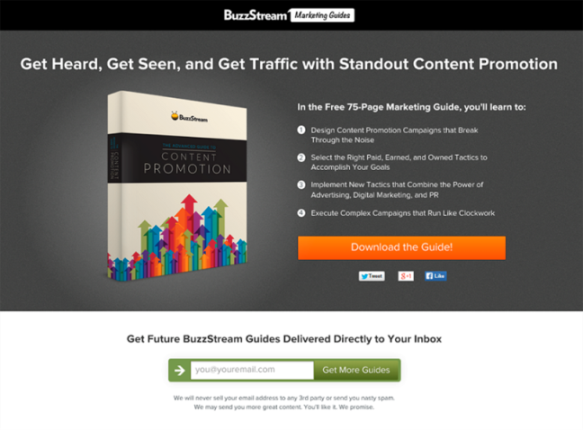
Users do not need to provide their email in the contact collection form at the bottom of the page, but BuzzStream relies on potential customers who receive a gift to more likely express their gratitude by providing an email address.
Matt Gratt, senior marketing manager at BuzzStream, told me that due to the opportunity to get something valuable for free, more people wanted to download the guide and mentioned it - for example, in the Moz video blog, links to it were also indicated on several other resources.
“Offer something for free before asking you to fulfill some obligation.”
How Noah Kagan uses the principle of reciprocity
Noah Kagan makes the principle of mutually beneficial exchange work by creating posts on his blog where he offers premium content packages in exchange for registration.
For example, a post on how to become the best seller on Amazon , step by step leads readers through the entire process of moving to the top sellers, the article is supplemented with screenshots, statistics, etc. In the end, readers are offered an additional bonus - more content in exchange for an email address.

Source
After reading such an amount of detailed information, the principle of reciprocity, supplemented by self-interest, is really a good reason to fill out a contact collection form.
How HubSpot uses reciprocity
Another example of using the principle of mutually beneficial exchange in action is the free product of the incoming marketing giant HubSpot's Marketing Grader .

Source
Free tool allows users to enter data to get from 1 to 100 points for them, which are set based on the quality of different methods of marketing promotion in the complex: blogging, social media, SEO, lead generation and mobile optimization. As with BuzzStream, HubSpot offers the Marketing Grader tool for free.
Based on the principle of reciprocity, users who are satisfied with this free service offered by HubSpot are more likely to want to somehow thank the company, and the report refers to the free trial version of HubSpot in this report:
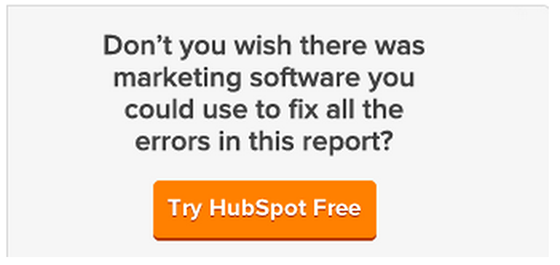
Source
The reciprocity principle served HubSpot faithfully - during the first three years of using HubSpot's Website Grader (an earlier version of Marketing Grader) they shared it on social networks a huge number of times, as a result of this tool it analyzed more than two million sites.
How to use the principle of reciprocity on your landing page:
- Offer something for free first.
- Then offer something more valuable, in exchange for some obligations for the site visitor.
The principle of consistency in obligations
People are usually very proud to be true to their word. Chaldini believes that both verbal and written commitments are powerful persuasion techniques: people tend to value an arrangement even when the initial incentive or motivation is no longer relevant.
If you have ever been to a car dealer to buy a new car, then you have probably seen this principle in action. After a test drive, you are usually brought back to the sales office to agree on the terms of the purchase. One of the first things you are asked to do is to indicate the conditions that suit you, or confirm the conditions specified by the sales manager.
These conditions are inconclusive and even unofficial, but the mere fact of naming them is a small obligation necessary to push you to take on big obligations (up to the intention to buy a car).
How Conversion Voodo Uses Consistency in Commitment
This principle can be applied to your landing page. Conversion Voodo helped the mortgage company increase the conversion rate to completed applications by more than 11% by adding a checkbox with a commitment microcopy:

This mini-commitment (combined with declarative approval) prepares users for a 20-minute application process.
How the Obligations Principle Was Used in Obama's Campaign
In the Obama campaign, this principle was involved in the redesign of the donation form . Having divided the process of collecting donations into several consecutive steps, they increased the conversion by 5%, a much larger amount of money was collected.
The redesign was effective, in particular, because the principle of consistency in obligations was correctly used in the new form. The first step was to select the amount that the user would like to donate.
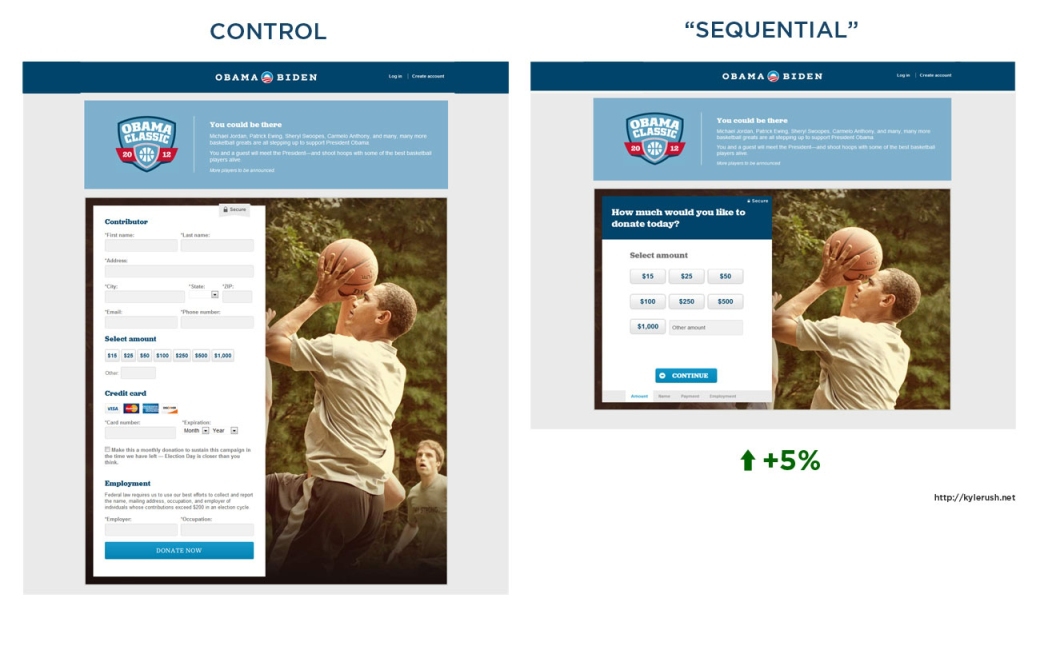
Source
Thus, already in the first step, the user made some commitment, and in order to fill out the entire form, it was necessary to go through several more such steps. People like to consider themselves consistent and rational - indicating the amount of the donation at the very beginning, they kind of commit themselves to finish what they started.
You do not need to completely redo the entire landing page to start using the principle of consistency. If you have a very long and complicated sales funnel, mini-commitments, which are declarative statements of a positive nature, will help users maintain interest in your product throughout the process, which will increase conversion.
How to use the principle of consistency in obligations on your landing:
- Ask the user to give very little obligation at the very beginning.
- Divide what you ask for into a few simple steps.
Principle of social approval
The principle of public recognition or social approval is based on the fact that in times of uncertainty people tend to do what others do.
Chaldini analyzed an experiment in which researchers participating in a door-to-door charity found that people were more likely to make donations when the list of those who had already done so was longer. If this list included people whom a potential participant of the rally knows, for example, his friends and neighbors, then he was more likely to agree to donate money.
How Conversion Rate Experts use the principle of social approval
DaFlores, a South American flower delivery store, was able to nearly double its revenue by adding an element of social approval to its landing page. In the original version of the site, a banner was used that took turns showing three customer reviews:

The initial version with three reviews in rotation - Source
After several studies, it was found that some new visitors had never heard of daFlores before, so representatives of the Conversion Rate Experts decided to demonstrate the popularity of daFlores replacing the rotation banner with a static image that read “¡GRACIAS a nuestros mas de 600,000 seguidores en Facebook!” - “Thanks to our 600,000+ Facebook followers!”

Tested version with a static image that says “Thanks to our 600,000+ Facebook followers!” - Source
This simple change has led to an increase in online flower sales by 44%. Those who saw that daFlores already has over 600,000 subscribers probably realized that it was a really great company providing quality services. Here it is - the power of social approval.
However, as this example shows, social approval is a two-edged sword. If your reviews do not look convincing enough or even seem false, the principle of social approval will work against you. Even if the review is true, but looks fake, it can lead to a negative opinion of the public, and alienate visitors to the site.
Most people forget that the important point about the principle of social approval is that it works more effectively when you use the feedback from users who are relevant to your target audience. You need to provide convincing evidence that your product is positively perceived by users who are similar to your client - then it is more likely to follow the crowd.
How to use the principle of social approval on your landing:
- Use compelling feedback from users who are part of your target audience.
- Use the icons to highlight popular products and price choices.
Principle of authority
In his book, Cialdini notes that people tend to bow to authorities - even when they are asked to commit reprehensible acts. As an example, he cites Milgram’s infamous experiments in which people tortured other people with electric shocks simply because an authoritative person stated that they should do this. The tendency to respect authorities is often used to increase the sales efficiency of absolutely everything - from shoes to toothpaste.
How Ultraviolet Digital Marketing Agency Uses Authority
Ultraviolet Digital was able to increase sales of its customer, Kaya Skin Clinic , by 22% just by changing the call to action.

The original version with a generalized call to action - Source
Despite the fact that this is found in the text above, Ultraviolet Digital specialists found that using the word “expert” in the form of contact collection as a call to action is an effective call to listen to the opinion of the authority.

The title of the contact collection form is “I want to know the opinion of experts. Register me! ”Uses the principle of authority. This version surpassed the original one by 137% - Source
In this example, it was not even necessary to appeal to the opinion of any particular authority - only an emphasis on the word “expert” makes the page 137% more effective in attracting customers.
Even despite the terrible text on the button, Kaya Skin Clinic saw concrete results after they added an authority element to it. Imagine what the effect would be if they combined appeal to authority with a more active call on the button, for example, “Get my opinion for free!”.
Even if it seems to you that you have already used the principle of authority on your landing page, the example above shows that sometimes the rule “the more the better” works here. Think about how you can rephrase or beat an appeal to authority in order to highlight it more and increase conversion more.
How to use the principle of authority on your landing page:
- Use the opinion leader your visitors respect to encourage them to take action.
- Quote the experts and refer to their opinion, and also use information from authoritative sources.
The principle of sympathy
According to Chaldini, people are more likely to purchase a product if they like the person who sells it. This law includes the tendency to listen to the opinions of the most attractive people.
In addition to the simple use of images of attractive people (which does not work for all products), this principle can be most difficult to implement in an online environment. However, this does not mean that you cannot use the principle of sympathy to increase the conversion of your landing page.
How Airbnb uses the principle of sympathy
Airbnb used the sympathy principle to redesign its “underutilized and ineffective” program, increasing registrations and orders by more than 300% per day.

“Your friend Jason gave you a $ 25 discount on your first trip with Airbnb, the best way to travel. Be sure to thank him! ” Source
Instead of a random customer list next to the Airbnb logo, potential buyers see (and associate with Airbnb) a friend’s smiling face. For each potential client, the first acquaintance with Airbnb takes place on a personalized landing page and immediately engages in the process. What might not like here?
How Help Scout uses the principle of sympathy
Similarly, by combining conversational text and a friendly person, Help Scout customer support service uses the principle of sympathy on the page below.
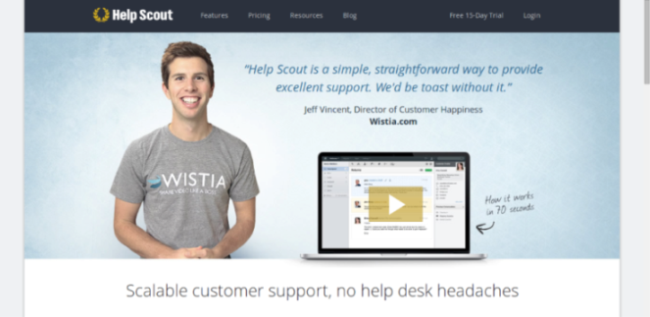
Help Scout is an easy customer support tool that many startups like.
Their page includes a picture of a smiling man - which appeals to the principle of sympathy. In this case, this is not even a friend from social networks - it is a real person with whom visitors can contact.
Please note that applying the principle of sympathy is not limited to visual elements. The text at the bottom of the page and next to the photo is written in an ordinary conversational style to make Help Scout an even simpler and more understandable service.
Writing text on a landing page in a friendly and simple manner is one of several ways to use the power of sympathy to your advantage. Another method is to beat the resemblance to the target audience, as people tend to like those with whom they have something in common. Think about who your target user is and how your interests, hobbies and values can help build a closer relationship with him and increase his liking for you.
How to use the principle of sympathy on your landing page:
- Use photos of friendly people who belong to your target audience.
- Speak with visitors to your site in their language and in a friendly tone - it's worth writing texts on a landing page.
- Treat visitors in such a way that they feel that they are communicating with people just like themselves.
Deficit principle
According to Cialdini, scarcity (whether real or far-fetched) creates demand and thus forces the buyer to act quickly. The abundance of "time-limited offers" and the expiration date on vouchers and coupons only confirm this principle.
How KISSmetrics uses scarcity
When Heiten Shah reduced the free trial period from 30 to 14 days, the number of customers involved in the process increased by 102%.
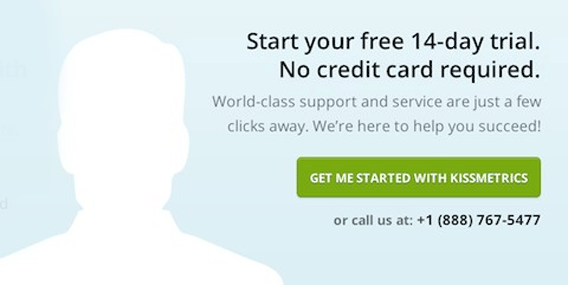
Source
Despite the fact that there was no difference in the number of registrations between the 30-day and 14-day trial periods, it turned out that users with a higher (102%) probability would actually use the product if they only have 14 days to do it.
While the conversion rate remained at the same level, an increase in the number of customers who actually used the product during the trial period allowed more users to evaluate the merits of the product, in the end, this led to an increase in revenue, as more users tried the product and then switched to the paid version.
How Quick Sprout uses the principle of scarcity
Neil Patel, a business partner of Heiten, uses a countdown clock on the landing page of his Quick Sprout University.

Source
Such an advantageous offer puts pressure on the user to make a choice: make a purchase or lose this chance forever. Fear of missed opportunity is the driving force behind the principle of scarcity.
In the Quick Sprout example, potential customers who were given too much time — a whole month — did not care at all to start using the product during the free trial period. Learn the ways in which you could formulate your own stocks, emphasizing the limited supply, and you can increase the degree of user engagement and conversion rate.
How to use the deficit principle on your landing page:
- Create time or quantity limited offers.
- Use a countdown clock to let users feel fear of missing a profitable opportunity.
What do many of the given cases have in common? Perhaps this is that the changes made cannot be called global. Even minor changes, supported by proven psychological principles and knowledge of your client, will help you to achieve excellent results.
Look at your landing page and tune in to an internal Chaldini. What changes can you easily make right now, using the power of persuasion of the six principles to increase the conversion of your landing pages?
Only registered users can participate in the survey. Please come in.
Which of the above principles of persuasion do you use in your work?
- 18.6% Reciprocity 14
- 17.3% Consistency in Obligations 13
- 24% Social Approval 18
- 33.3% Authority 25
- 21.3% Sympathy 16
- 22.6% Deficit 17
- 32% None 24
